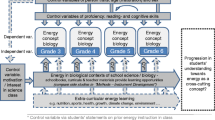Abstract
This article describes the development and implementation in the schools over a 20-year period of the Energy Source Program, a comprehensive K-12 energy education curriculum. The program was developed beginning in 1980 using state-of-the-art development procedures for that time and has been used to date by more than 12 million American students to learn about energy and energy issues. End-of-unit posttest scores for the elementary and high school units averaged above 80% for their field tests. Data obtained from a large sample during the first three years of installation of the program in the schools indicated that posttest scores remained at a level during installation similar to that during the field-test phase. A study conducted in the early 1990s by an independent research organization to assess the program's long-term effects revealed that grade 6 students who had used one or more units from the program had significantly greater energy knowledge and better energy conservation habits than students who had not used any units. A set of 10 guidelines are offered for long-term instructional development and implementation projects.
Similar content being viewed by others
References
Bloom, B.S., Englehardt, M.D., Faust, E.J., Hill, W.H., & Krathwohl, D.R. (1956).Taxonomy of educational objectives: Handbook I, the cognitive domain. New York: Longmans-Green.
Dick, W., & Carey, L. (1978).The systematic design of instruction. Glenville, IL: Scott-Foresman.
Duffy, T., & Cunningham, D. (1996). Constructivism: Implications for the design and delivery of instruction. In D. Jonassen (Ed.)Handbook of Research for Educational Communications and Technology, (pp. 170–198). New York: Macmillan.
Energy: Knowledge and attitudes. (1978). Denver: National Assessment of Educational Progress, Education Commission of the States.
Hanson, R.A. (1993). Long-term effects of the Energy Source Education Program.Studies in Educational Evaluation, 19(4), 363–382.
Jonassen, D.H. (1991). Objectivism versus constructivism: Do we need a new philosophical paradigm?Educational Technology Research and Development, 39(3), 5–14.
Monthly Energy Review. (1983, December). U.S. city average retail price for motor gasoline,2, 88.
Richey, R.C. (1997). Research on Instructional Development.Educational Technology Research and Development, 45(3), 91–100.
Sullivan, H. (1971). Developing effective objectives-based instruction.Educational Technology, XI(7), 55–57.
Sullivan, H. (1984). Instructional development through a national industry-educational partnership.Journal of Instructional Development, 7(4), 17–22.
Author information
Authors and Affiliations
Additional information
He supervised the development of the Energy Source Program from 1980 to 1984 while serving as a consultant to EDS.
Kay Ice was Director of Program Development at EDS, and she was a primary writer and developer of the Energy Source Program. She has been president of EDS since 1999.
Fred Niedermeyer was the founding president of EDS. He was project director of the Energy Source project, and he played a major role in all aspects of the project from its inception until his retirement in 1999.
Rights and permissions
About this article
Cite this article
Sullivan, H., Ice, K. & Niedermeyer, F. Long-term instructional development: A 20-year ID and implementation project. ETR&D 48, 87–99 (2000). https://doi.org/10.1007/BF02300501
Issue Date:
DOI: https://doi.org/10.1007/BF02300501



